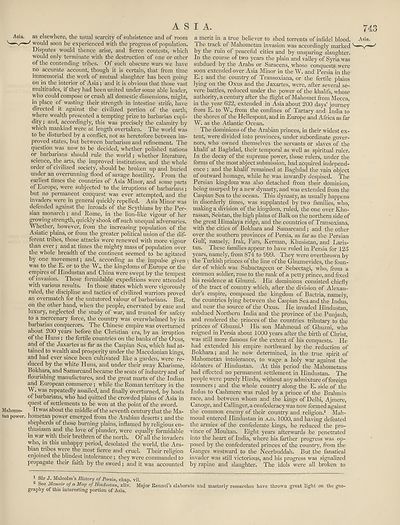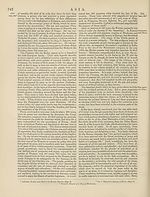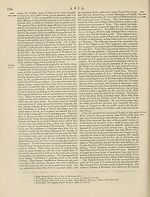Encyclopaedia Britannica > Volume 3, Anatomy-Astronomy
(751) Page 743
Download files
Complete book:
Individual page:
Thumbnail gallery: Grid view | List view

A S
Asia, as elsewhere, the usual scarcity of subsistence and of room
would soon be experienced with the progress of population.
Disputes would thence arise, and fierce contests, which
would only terminate with the destruction of one or other
of the contending tribes. Of such obscure wars we have
no accurate account, though it is certain, that from time
immemorial the work of mutual slaughter has been going
on in the interior of Asia; and it is obvious that those vast
multitudes, if they had been united under some able leader,
who could compose or crush all domestic dissensions, might,
in place of wasting their strength in intestine strife, have
directed it against the civilized portion of the earth,
where wealth presented a tempting prize to barbarian cupi¬
dity ; and, accordingly, this was precisely the calamity by
which mankind were at length overtaken. The world was
to be disturbed by a conflict, not as heretofore between im¬
proved states, but between barbarism and refinement. The
question was now to be decided, whether polished nations
or barbarians should rule the world; whether literature,
science, the arts, the improved institutions, and the whole
order of civilized society, should be broken up and buried
under an overrunning flood of savage hostility. From the
earliest times the countries of Asia Minor, and some parts
of Europe, were subjected to the irruptions of barbarians;
but no permanent conquest was ever attempted, and the
invaders were in general quickly repelled. Asia Minor was
defended against the inroads of the Scythians by the Per¬
sian monarch; and Rome, in the lion-like vigour of her
growing strength, quickly shook off such unequal adversaries.
Whether, however, from the increasing population of the
Asiatic plains, or from the greater political union of the dif¬
ferent tribes, those attacks were renewed with more vigour
than ever; and at times the mighty mass of population over
the whole breadth of the continent seemed to be agitated
by one movement; and, according as the impulse given
was to the E. or to the W., the kingdoms of Europe or the
empires of Hindustan and China were swept by the tempest
of invasion. Those formidable expeditions were attended
with various results. In those states which were vigorously
ruled, the discipline and tactics of civilized warriors proved
an overmatch for the untutored valour of barbarians. But,
on the other hand, when the people, enervated by ease and
luxury, neglected the study of war, and trusted for safety
to a mercenary force, the country was overwhelmed by its
barbarian conquerors. The Chinese empire was overturned
about 200 years before the Christian era, by an irruption
of the Huns; the fertile countries on the banks of the Oxus,
and of the Jaxartes as far as the Caspian Sea, which had at¬
tained to wealth and prosperity under the Macedonian kings,
and had ever since been cultivated like a garden, were re¬
duced by the white Huns, and under their sway Kharisme,
Bokhara, and Samarcand became the seats of industry and of
flourishing manufactures, and the great marts of the Indian
and European commerce ; while the Roman territory in the
W. was repeatedly assailed, and finally overturned, by hosts
of barbarians, who had quitted the crowded plains of Asia in
quest of settlements to be won at the point of the sword.
Mahome- It was about the middle of the seventh century that the Ma-
tan power, hometan power emerged from the Arabian deserts ; and the
shepherds of those burning plains, inflamed by religious en¬
thusiasm and the love of plunder, were equally formidable
in war with their brethren of the north. Of all the invaders
who, in this unhappy period, desolated the world, the Ara-
bian. tribes were the most fierce and cruel. Their religion
enjoined the blindest intolerance ; they were commanded to
piopagate their faith by the sword; and it was accounted
I A. 743
a merit in a true believer to shed torrents of infidel blood. Asia.
The track of Mahometan invasion was accordingly marked
by the ruin of peaceful cities and by unsparing slaughter.
In the course of two years the plain and valley of Syria was
subdued by the Arabs or Saracens, whose conquests were
soon extended over Asia Minor in the W. and Persia in the
E.; and the country of Transoxiana, or the fertile plains
lying on the Oxus and the Jaxartes, were, after several se¬
vere battles, reduced under the power of the khalifs, whose
authority, a century after the flight of Mahomet from Mecca,
in the year 622, extended in Asia about 200 days’ journev
from E. to W., from the confines of Tartary and India to
the shores of the Hellespont, and in Europe and Africa as far
W. as the Atlantic Ocean.
The dominions of the Arabian princes, in their widest ex¬
tent, were divided into provinces, under subordinate gover¬
nors, who owned themselves the servants or slaves of the
khalif at Baghdad, their temporal as well as spiritual ruler.
In the decay of the supreme power, those rulers, under the
forms of the most abject submission, had acquired independ¬
ence ; and the khalif remained at Baghdad the vain object
of outward homage, while he was inwardly despised. The
Persian kingdom was also detached from their dominion,
being usurped by a new dynasty, and was extended from the
Caspian Sea to the ocean. This dynasty, as usually happens
in disorderly times, was supplanted by two families, who,
making a division of the kingdom, ruled, the one over Kho-
rassan, Seistan, the high plains of Balk on the northern side of
the great Himalaya ridge, and the countries of Transoxiana,
with the cities of Bokhara and Samarcand; and the other
over the southern provinces of Persia, as far as the Persian
Gulf, namely, Irak, Ears, Kerman, Khusistan, and Laris-
tan. These families appear to have ruled in Persia for 125
years, namely, from 874 to 999. They were overthrown by
the Turkish princes of the line of the Ghuznevides, the foun¬
der of which was Subuctageen or Sebectagi, who, from a
common soldier, rose to the rank of a petty prince, and fixed
his residence at Ghuzni. His dominions consisted chiefly
of the tract of country which, after the division of Alexan¬
der’s empire, composed the kingdom of Bactria, namely,
the countries lying between the Caspian Sea and the Indus,
and near the source of the Oxus. He invaded Hindustan,
subdued Northern India and the province of the Punjaub,
and rendered the princes of the countries tributary to the
princes of Ghuzni.1 His son Mahmoud of Ghuzni, who
reigned in Persia about 1000 years after the birth of Christ,
was still more famous for the extent of his conquests. He
had extended his empire northward by the reduction of
Bokhara; and he now determined, in the true spirit of
Mahometan intolerance, to wage a holy war against the
idolaters of Hindustan. At this period the Mahometans
had effected no permanent settlement in Hindustan. The
people were purely Hindu, without any admixture of foreign
manners; and the whole country along the E. side of the
Indus to Cashmere was ruled by a prince of the Brahmin
race, and between whom and the kings of Delhi, Ajmere,
Canoge, and Callinger, a confederacy was now formed against
the common enemy of their country and religion.2 Mah¬
moud entered Hindustan in a.d. 1000, and having defeated
the armies of the confederate kings, lie reduced the pro¬
vince of Moultan. Eight years afterwards he penetrated
into the heart of India, where his farther progress was op¬
posed by the confederated princes of the country, from the
Ganges westward to the Neerbuddah. But the fanatical
invader was still victorious, and his progress was signalized
by rapine and slaughter. The idols were all broken to
* Sir *T. Malcolm s History of Persia, chap. vii.
See Memoir of a Map of Ilindostan, xliv. Major Rennel’s elaborate and masterly researches have thrown great light on the geo¬
graphy of this interesting portion of Asia.
Asia, as elsewhere, the usual scarcity of subsistence and of room
would soon be experienced with the progress of population.
Disputes would thence arise, and fierce contests, which
would only terminate with the destruction of one or other
of the contending tribes. Of such obscure wars we have
no accurate account, though it is certain, that from time
immemorial the work of mutual slaughter has been going
on in the interior of Asia; and it is obvious that those vast
multitudes, if they had been united under some able leader,
who could compose or crush all domestic dissensions, might,
in place of wasting their strength in intestine strife, have
directed it against the civilized portion of the earth,
where wealth presented a tempting prize to barbarian cupi¬
dity ; and, accordingly, this was precisely the calamity by
which mankind were at length overtaken. The world was
to be disturbed by a conflict, not as heretofore between im¬
proved states, but between barbarism and refinement. The
question was now to be decided, whether polished nations
or barbarians should rule the world; whether literature,
science, the arts, the improved institutions, and the whole
order of civilized society, should be broken up and buried
under an overrunning flood of savage hostility. From the
earliest times the countries of Asia Minor, and some parts
of Europe, were subjected to the irruptions of barbarians;
but no permanent conquest was ever attempted, and the
invaders were in general quickly repelled. Asia Minor was
defended against the inroads of the Scythians by the Per¬
sian monarch; and Rome, in the lion-like vigour of her
growing strength, quickly shook off such unequal adversaries.
Whether, however, from the increasing population of the
Asiatic plains, or from the greater political union of the dif¬
ferent tribes, those attacks were renewed with more vigour
than ever; and at times the mighty mass of population over
the whole breadth of the continent seemed to be agitated
by one movement; and, according as the impulse given
was to the E. or to the W., the kingdoms of Europe or the
empires of Hindustan and China were swept by the tempest
of invasion. Those formidable expeditions were attended
with various results. In those states which were vigorously
ruled, the discipline and tactics of civilized warriors proved
an overmatch for the untutored valour of barbarians. But,
on the other hand, when the people, enervated by ease and
luxury, neglected the study of war, and trusted for safety
to a mercenary force, the country was overwhelmed by its
barbarian conquerors. The Chinese empire was overturned
about 200 years before the Christian era, by an irruption
of the Huns; the fertile countries on the banks of the Oxus,
and of the Jaxartes as far as the Caspian Sea, which had at¬
tained to wealth and prosperity under the Macedonian kings,
and had ever since been cultivated like a garden, were re¬
duced by the white Huns, and under their sway Kharisme,
Bokhara, and Samarcand became the seats of industry and of
flourishing manufactures, and the great marts of the Indian
and European commerce ; while the Roman territory in the
W. was repeatedly assailed, and finally overturned, by hosts
of barbarians, who had quitted the crowded plains of Asia in
quest of settlements to be won at the point of the sword.
Mahome- It was about the middle of the seventh century that the Ma-
tan power, hometan power emerged from the Arabian deserts ; and the
shepherds of those burning plains, inflamed by religious en¬
thusiasm and the love of plunder, were equally formidable
in war with their brethren of the north. Of all the invaders
who, in this unhappy period, desolated the world, the Ara-
bian. tribes were the most fierce and cruel. Their religion
enjoined the blindest intolerance ; they were commanded to
piopagate their faith by the sword; and it was accounted
I A. 743
a merit in a true believer to shed torrents of infidel blood. Asia.
The track of Mahometan invasion was accordingly marked
by the ruin of peaceful cities and by unsparing slaughter.
In the course of two years the plain and valley of Syria was
subdued by the Arabs or Saracens, whose conquests were
soon extended over Asia Minor in the W. and Persia in the
E.; and the country of Transoxiana, or the fertile plains
lying on the Oxus and the Jaxartes, were, after several se¬
vere battles, reduced under the power of the khalifs, whose
authority, a century after the flight of Mahomet from Mecca,
in the year 622, extended in Asia about 200 days’ journev
from E. to W., from the confines of Tartary and India to
the shores of the Hellespont, and in Europe and Africa as far
W. as the Atlantic Ocean.
The dominions of the Arabian princes, in their widest ex¬
tent, were divided into provinces, under subordinate gover¬
nors, who owned themselves the servants or slaves of the
khalif at Baghdad, their temporal as well as spiritual ruler.
In the decay of the supreme power, those rulers, under the
forms of the most abject submission, had acquired independ¬
ence ; and the khalif remained at Baghdad the vain object
of outward homage, while he was inwardly despised. The
Persian kingdom was also detached from their dominion,
being usurped by a new dynasty, and was extended from the
Caspian Sea to the ocean. This dynasty, as usually happens
in disorderly times, was supplanted by two families, who,
making a division of the kingdom, ruled, the one over Kho-
rassan, Seistan, the high plains of Balk on the northern side of
the great Himalaya ridge, and the countries of Transoxiana,
with the cities of Bokhara and Samarcand; and the other
over the southern provinces of Persia, as far as the Persian
Gulf, namely, Irak, Ears, Kerman, Khusistan, and Laris-
tan. These families appear to have ruled in Persia for 125
years, namely, from 874 to 999. They were overthrown by
the Turkish princes of the line of the Ghuznevides, the foun¬
der of which was Subuctageen or Sebectagi, who, from a
common soldier, rose to the rank of a petty prince, and fixed
his residence at Ghuzni. His dominions consisted chiefly
of the tract of country which, after the division of Alexan¬
der’s empire, composed the kingdom of Bactria, namely,
the countries lying between the Caspian Sea and the Indus,
and near the source of the Oxus. He invaded Hindustan,
subdued Northern India and the province of the Punjaub,
and rendered the princes of the countries tributary to the
princes of Ghuzni.1 His son Mahmoud of Ghuzni, who
reigned in Persia about 1000 years after the birth of Christ,
was still more famous for the extent of his conquests. He
had extended his empire northward by the reduction of
Bokhara; and he now determined, in the true spirit of
Mahometan intolerance, to wage a holy war against the
idolaters of Hindustan. At this period the Mahometans
had effected no permanent settlement in Hindustan. The
people were purely Hindu, without any admixture of foreign
manners; and the whole country along the E. side of the
Indus to Cashmere was ruled by a prince of the Brahmin
race, and between whom and the kings of Delhi, Ajmere,
Canoge, and Callinger, a confederacy was now formed against
the common enemy of their country and religion.2 Mah¬
moud entered Hindustan in a.d. 1000, and having defeated
the armies of the confederate kings, lie reduced the pro¬
vince of Moultan. Eight years afterwards he penetrated
into the heart of India, where his farther progress was op¬
posed by the confederated princes of the country, from the
Ganges westward to the Neerbuddah. But the fanatical
invader was still victorious, and his progress was signalized
by rapine and slaughter. The idols were all broken to
* Sir *T. Malcolm s History of Persia, chap. vii.
See Memoir of a Map of Ilindostan, xliv. Major Rennel’s elaborate and masterly researches have thrown great light on the geo¬
graphy of this interesting portion of Asia.
Set display mode to:
![]() Universal Viewer |
Universal Viewer | ![]() Mirador |
Large image | Transcription
Mirador |
Large image | Transcription
Images and transcriptions on this page, including medium image downloads, may be used under the Creative Commons Attribution 4.0 International Licence unless otherwise stated. ![]()
| Encyclopaedia Britannica > Encyclopaedia Britannica > Volume 3, Anatomy-Astronomy > (751) Page 743 |
|---|
| Permanent URL | https://digital.nls.uk/193767111 |
|---|
| Attribution and copyright: |
|
|---|---|
| Shelfmark | EB.16 |
|---|---|
| Description | Ten editions of 'Encyclopaedia Britannica', issued from 1768-1903, in 231 volumes. Originally issued in 100 weekly parts (3 volumes) between 1768 and 1771 by publishers: Colin Macfarquhar and Andrew Bell (Edinburgh); editor: William Smellie: engraver: Andrew Bell. Expanded editions in the 19th century featured more volumes and contributions from leading experts in their fields. Managed and published in Edinburgh up to the 9th edition (25 volumes, from 1875-1889); the 10th edition (1902-1903) re-issued the 9th edition, with 11 supplementary volumes. |
|---|---|
| Additional NLS resources: |
|

